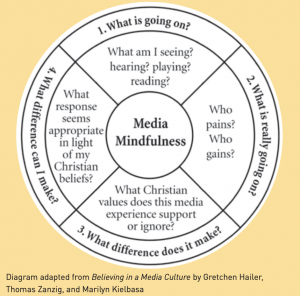
A digital strategy for becoming media mindful
SR. NANCY USSELMANN, FSP
Faced with a secularist culture and declining church attendance, the task of faith formation is critical and immense. Not only do faith formation leaders need to be on top of current educational practices, psychological developments, and multiple intelligences studies in their handing on of the faith, but they also have to make it all relevant within a digital media environment that has become the very ebb and flow of current human experience.
Hands down, all catechists deserve a round of applause for taking on this gargantuan task in the face of the popular media culture’s competition for our young people’s time and attention. Handing on the message of Jesus Christ that has been passed down to us through millennia in the Scriptures and Church Tradition seems to be straightforward since it is the same Truth that we have always proclaimed. Yet the media culture has created new ways of learning that can perhaps help us integrate these timeless truths into the way we live out our religious beliefs in this third millennium. It does not mean changing the message or watering it down, but it does mean making our Christian faith real, livable, and accessible to generations who know no other world than one that is wired 24/7.
A brief history
The Church, through the wisdom of the Holy Spirit, understands this. She has been advocating for media literacy education within faith formation implicitly in Vatican II’s Decree on Social Communications (Inter Mirifica) and explicitly beginning with Communio et Progressio in 1971 by the Pontifical Council for Social Communication. St. John Paul II, in his World Communications Day messages, encouraged the Church to not be afraid to enter into the media culture and teach our youth how to be critical engagers of the media they consume. Pope Benedict developed this concept even further into the digital realm when Facebook and Twitter created new possibilities for connection while he offered media literacy education as a way to provide balance in a rapidly changing culture of communication. Pope Francis reminds us what it means to be human within a digital experience and praises the technological developments while also offering an opportunity to reflect on what we do with these gifts of God.
Using the Internet for Good: “This is the network we want …”
A message from Pope Francis from World Communications Day, 2019“We are members one of another” (Ephesians 4:25). The image of the body and the members reminds us that the use of the social web is complementary to an encounter in the flesh that comes alive through the body, heart, eyes, gaze, breath of the other. If the Net is used as an extension or expectation of such an encounter, then the network concept is not betrayed and remains a resource for communion. If a family uses the Net to be more connected, to then meet at table and look into each other’s eyes, then it is a resource. If a Church community coordinates its activity through the network, and then celebrates the Eucharist together, then it is a resource. If the Net becomes an opportunity to share stories and experiences of beauty or suffering that are physically distant from us, in order to pray together and together seek out the good to rediscover what unites us, then it is a resource. We can, in this way … [open] the way for dialogue, for encounter, for “smiles” and expressions of tenderness. … This is the network we want, a network created not to entrap, but to liberate, to protect a communion of people who are free. The Church herself is a network woven together by Eucharistic communion, where unity is based not on “likes,” but on the truth, on the “Amen,” by which each one clings to the Body of Christ, and welcomes others.
Read the whole message at CATmag.us/2QU1Cxe.
An educational imperative
The National Directory for Catechesis by the United States Conference of Catholic Bishops recommends five main actions for catechists with regard to media. At the Pauline Center for Media Studies, where I work, we summarize those actions this way:
1. To develop critical thinking skills through media literacy education/media mindfulness (see chapter 10.B.3).
2. That media be the subject of catechesis and evangelization (see chapter 10.C).
3. To use media in catechesis (see chapter 10.B).
4. To produce media for catechesis and evangelization (see chapter 10.B).
5. To advocate for authentic media (see chapter 10.B).
The first action is to develop critical thinking skills through media literacy education and media mindfulness strategies. What does this mean exactly? Media literacy, as defined by the Center for Media Literacy, is the ability to access, analyze, evaluate, create, and participate in media messages. Media mindfulness takes this media literacy concept and adds a theological reflection framework to it that integrates values articulation into the media literacy pedagogy. Media mindfulness is media literacy within faith formation.
Media mindfulness

Integrating a media mindfulness strategy into faith formation is about helping children, young people, and adults to ask questions of the media they create and consume. Although these media are gifts, they do not always promote what is true, good, and beautiful, and therefore they often do not support the dignity of the human person. It is even more crucial for Catholics to know and understand how their values, and specifically the Gospel values we teach in catechesis, help them live happy and fulfilled lives within the all-encompassing digital environment. Too many parents and teachers sit on either extreme of the media use spectrum: “It’s all evil and should be avoided” or “It’s hard to say no since all their friends are watching/using it.”
Both of these approaches are unhelpful since neither guide children to be discerning Christians today. If we do not give our youth the skills to integrate these values into their everyday choices, then they will not have faith as a foundation and grounding force in their future lives. Teaching the faith is not for the moment but for a lifetime.
The methodology is circular since the questions help us go deeper as we move along in the discernment process of our media experience. The Media Mindfulness Wheel can be a guide in making media literacy part of all of our faith formation experience.
This method of theological reflection can be used with any popular media artifact: movie, song, TV show, social media feed, YouTube video, or video game. Strategizing ways to insert media mindfulness in a religious formation setting puts critical thinking and discernment skills at the core of a lived faith. Try using the Media Mindfulness wheel with some element of popular culture, and you will see youth perk up in class. This is a great way of discussing the Ten Commandments, the sacraments, and our belief in God by evaluating how or if the artifact of the culture alludes to the human yearning for that something more, that deep human desire for God.
SR. NANCY USSELMANN, FSP, is a Daughter of St Paul and the director of the Pauline Center for Media Studies in Los Angeles. She is a media literacy education specialist, speaker, theologian, and film reviewer for BeMediaMindful.org. Her book is a theology of popular culture entitled, A Sacred Look: Becoming Cultural Mystics.
PHOTOS: WAVEBREAKMEDIA/ SHUTTERSTOCK, ST. MARY’S PRESS (USED WITH PERMISSION)
This article was originally published in Catechist, February 2020.




